

Dungeon Siege 3 diverges from its forebears to such a degree that it should almost have had a different title. Players expecting the traditional PC RPG trappings of the first two games: character creation, large parties, pause-and-go strategy, mouse and keyboard oriented gameplay, will almost certainly be disappointed. That’s what this game isn’t. What it is, however, is a polished and addictive button-mashing action-RPG that succeeds in creating a story-oriented co-op fantasy dungeon crawler for modern console audiences in the tradition of Secret of Mana or Baldur’s Gate: Dark Alliance. In fact, the game’s lead designer, Nathaniel Chapman, mentioned both of those games by way of comparison in our recent interview with him.
Dungeon Siege 3 returns the series to the first game’s Kingdom of Ehb, a fairly generic fantasy setting once protected by a group of honor-bound warriors called the 10th Legion. At the opening of DS3, the Legion has been all but obliterated by the armies of a religious zealot called Jeyne Kassynder, who holds the Legion responsible for the murder of the former King of Ehb and has dedicated her life to vengeance against them. You and the other playable characters are part of a mere handful of surviving Legionnaires, and your quest involves reuniting the various splintered factions of Ehb with the remnants of the Legion. All this game’s talk of Legions actually led to a few humorous moments for me when NPCs would celebrate how, “The Legion has returned,” and I’d think, “Well, yes, but it’s basically me and this other guy.” The abstract arc of the story is superficially similar to that of Dragon Age: Origins: as a new member of an elite but dwindling order you recruit allies amongst the kingdom’s squabbling factions by doing quests for them until you have enough force to march against the Bad Thing. But what has been will be again, what has been done will be done again; there is nothing new under the sun.
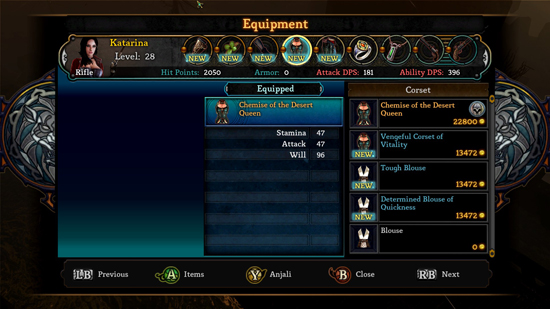
Though the Dungeon Siegefranchise was originally developed by Gas Powered Games for Microsoft (and later 2K Games), Obsidian is known for taking on sequel projects from other developers, most notably the sequels to BioWare’s Star Wars: Knights of the Old Republic and Bethesda’s Fallout 3. Their sole wholly original property to date, Alpha Protocol, underperformed, though arguably for reasons tangential to the game itself. Every Obsidian game preceding DS3 has suffered from technical issues of varying degrees: from the literally unfinished KOTOR 2 to the crashes and corrupted saves of Fallout: New Vegas.
Yet these glitches and rough edges have largely been balanced by the excellence of each of these game’s stories and characters. Fortunately, from my experience so far, having played through this game twice as different characters while doing every side quest and vacuuming up every bit of coin and loot I could lay my hands on, it appears Obsidian have maintained their winning tradition in the writing department, while also delivering a solid and highly polished technical experience. Playing the PC version, I experienced absolutely zero significant issues: no crashes, no unfinishable quests, no pathing weirdness, and no corrupted saves — even though I never passed a save point without using it. It also ran smoothly and looked gorgeous on maxed settings even on my fairly mid-range PC.
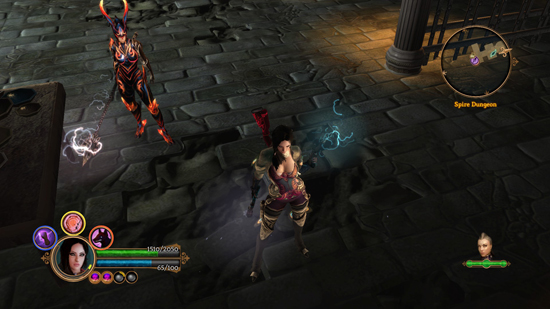
But yes, I said “save point.” Even on the PC, you can’t just save wherever you wish. Luckily, the save points are logically and generously placed, so it wasn’t too much of an issue. The fact that one was located immediately before (and after) every major encounter was nice, but also took some of the element of surprise and danger out of it. Seeing a save point in a dungeon became like seeing a chest-high wall ahead in Mass Effect 2, “Gee, I wonder if this means I’m about to be attacked?” On “Normal” difficulty, experienced players will hardly need any saves anyway. Normal was just hard enough to force me to use most of my abilities to my best advantage, but not so hard that I was ever likely to throw my controller. Like Dungeon Siege 2, you only “die” if everyone in your party is dead simultaneously. Throughout the game on Normal, there were a few moments where my character was knocked out, but luckily my AI party member was useful enough to hold their own until they could resurrect me. Only a few times in Normal did we completely “wipe” and have to reload. Hardcore was a different story entirely. I wiped hard and repeatedly, particularly in the early game before I picked up any party members or learned many abilities. Even ordinary packs of mobs had to be kited and hit-and-run tactics applied.

Personally, I found the friendly AI impressive. My counterpart used all his or her abilities well and was genuinely useful, doing a significant part of the damage and saving my ass several times. A good thing, too, because unlike previous Dungeon Siege games, apart from picking gear and talents you have absolutely zero control over your party member in combat. The only real issue I saw with the party AI was that it sometimes didn’t know not to stand in what RPG gamers call “the poop,” whatever it was: environmental hazards that caused damage just by standing in them or walking through them. This actually caused my one wipe on Normal during what I considered the most interesting and challenging boss fight of the game, which occurs at the end of the second act. Pet AI was also less impressive, often behaving like a World of Warcraft Hunter’s pet set to aggressive, going after far off-screen packs of enemies on their own volition.
The boss fights, while well integrated into the story, were perhaps a bit uniform in terms of strategy. Almost every boss encounter, bar a few exceptions, consisted of the Big Bad teleporting around the room while summoning waves of mooks to harry me. Given the struggle my party member had with one truly interesting boss fight, I suspect that this lack of variety might have had something to do with the limitations of the otherwise competent friendly AI.
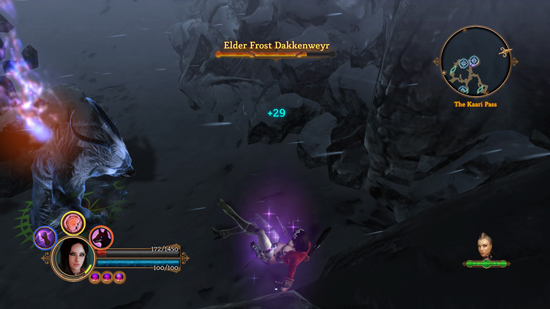
The idea of different forms of vulnerability which played such a large role in Dungeon Siege 2 is out as well. Instead, your tactical decisions consist of target prioritization and ability synergy. You have to maneuver well, dodging frequently, while trying to stun, slow, or knock back enemies who get too close. You will almost never be faced with only one form of attack. A group of mobs will almost always consist of melee fighters as well as ranged, and you’ll have to decide which poses the greatest threat. Early on ranged enemies are often the bigger threat, but in the end-game fast, hard-hitting melee enemies can take you down in seconds if you oblige them by standing still.
Your character’s abilities are toggled by switching stances, which generally break down into a long range, single target stance, a short range, crowd control stance, and a defensive dodging and healing stance. A given fight will have you switching between all three of these stances repeatedly. Instead of mana, which drains as you use spells and then refills itself automatically, you use Focus, which is built up by attacking enemies. You also slowly build a secondary form of power, which gives you the ability to occasionally supercharge one of your abilities. This gives the game a relentlessly offensive feel. No one is ever standing around waiting to be able to do something. The key is that all feels so smooth. Your abilities are so well designed, and juggling them requires just enough skill that combat, far from being a chore to get loot, becomes a joy in and of itself. Your choice of companion and preference of stance determine which abilities you’ll want to unlock first, though by the end of the game you’ll have all of them if you do every side-quest.
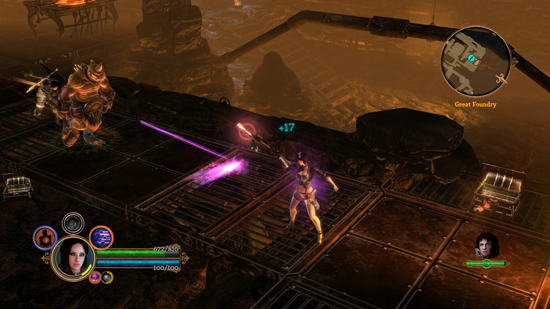
Though the four characters available conform roughly to standard RPG archetypes: warrior, mage, ranger, etc, there are no support characters. In fact, every single character can unlock some form of self-healing early on, and there’s isn’t even a single potion in sight. Customization comes in the form of unlocking the aforementioned abilities, and in Proficiencies and Talents. Proficiencies allow you to improve a given Ability in one of two ways. For example, if your character can summon a pet, you can either buff it or make its attacks heal you, or mix a little of both. I’m not the sort who would analyze loot in a spreadsheet, but itemization appeared well balanced, providing you with a steady stream of upgrades and side-grades at a reasonable pace. The inventory system was also easy to navigate and always notified you of which items were new. You can convert items to cash (at a steep loss) directly from your inventory, though I only learned this halfway through the game when I finally filled up my storage. My main complaint with the loot had to do with poorly defined statistics. Without tooltips or descriptions it was hard to decide between vaguely similar sounding stats like Armor, Block, and Warding, or why a piece with one stat was considered more valuable than another. The only way to find out what these stats did was to look them up in the glossary of the in-game Help menu.
The general structure of Dungeon Siege 3 is fairly linear. There’s no question which areas you’ll visit in which order, but in between you’ll have some room to explore. You’ll generally have three or four active quests at a time, and you can choose which order to do them in as it suits you. The game also rewards poking around in nooks and crannies to an almost comical degree. Go in the opposite direction of the Fable-like breadcrumb trail (oh yeah, there’s that, too, but it’s optional) leading you toward your next objective and you will always be rewarded materially.
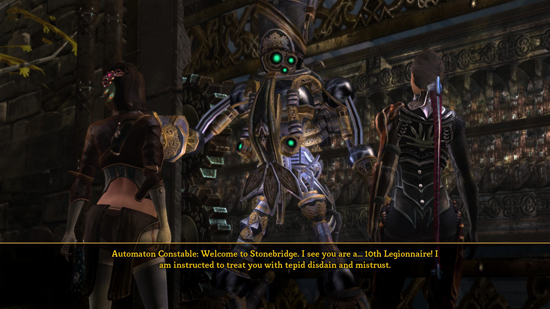
The environments, I thought, were gorgeous and detailed, from the forests in which you begin the game to the haunted mansions, snow-capped mountain passes, steampunk forges, and German-style Renaissance cities. They’re familiar fantasy environments, but lovingly created and packed with tiny details. I never got the feeling that I was being led through lazily copy-pasted filler. The standard enemies too, I felt were nicely varied, even though the early chapters might lead you to believe you’ll face nothing but human goons. I also enjoyed how changes to your character’s armor were reflected visually, right down to tiny details like the hairpins of gun-wielding Katarina, and by the end of the game each character looks quite distinct and markedly different from how they looked at the beginning.
Given that this game was obviously designed with co-op multiplayer in mind, it’s a shame that I’ve had so little first-hand experience with it thus far aside from a few hours of local co-op (SuicideGirls only got one review copy!). I did enjoy that it was drop-in, drop-out, so that my buddy could join me mid-game, quit where they wanted, and I could continue without them. The addition of a dialogue-choice voting system was a nice too. The second player’s preference for which dialogue option you should take in a conversation is always shown, and there are supposedly bonuses if the two of you consistently agree or disagree. Less welcome was a probable side effect of drop-in, drop-out: a player drops into your game with your characters, not their own, and any progress they make with a character in your game will not carry over to their copy of the game. The extreme top-down camera angle that had not bothered me before when I played alone also left me feeling nauseous for some reason at a few points in our multiplayer game when it rotated around. I’m not sure if it works this way in internet multiplayer, but in local co-op the camera’s insistence on always keeping my friend’s body in view also caused us a few wipes when they went down and my ability to move around the room suddenly became limited to the space within sight of their corpse.
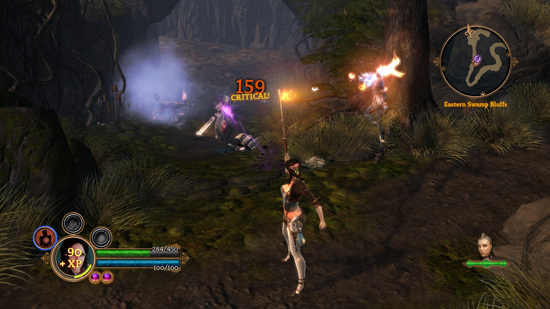
Within seconds of booting this game for the first time, I knew that hardcore PC gamers and especially fans of the old Dungeon Siegegames would instinctively hate it. It cannot be said clearly enough that this is a console game. The PC version might have higher resolution textures and other graphical whizzbangs, but otherwise it appears to be exactly the same as the Xbox 360 version, right down to the menus and UI. Some gamers hate the trend toward so-called “consolization” on principal. Personally, while I’d love to see a true PC RPG successor to the likes of Baldur’s Gate 2, I’m not holding my breath. Rather than rage about what I can’t change, I try to enjoy what I have. I don’t remember either of the first Dungeon Siege games ever being lauded as flawless untouchable classics, anyway.
And I enjoyed both times I’ve played through Dungeon Siege 3. If there were one word I could use to describe this game, it would be “solid.” It brought to mind classic arcade beat-’em-ups like Dungeons & Dragons: Shadow Over Mystara or console games like X-men: Legends. The joy of this game is in the gameplay, which I found rewarding in and of itself, and not especially in the roleplaying. The story did become more interesting as the game progressed though, and I eventually found myself transitioning from, “Yeah, yeah shut up and tell me where to go,” to looking for every extra line of dialogue. Obsidian’s strength has always been in their writing department. While this game may not have the open-ended freedom of their previous titles, it does possess some interesting characters and meaningful choices to be made throughout that affect the later course of the game in surprising ways, and this time Obsidian has wedded it to a game that’s as technically well crafted as its story.


[…] Related Posts: Dungeon Siege 3 In Review […]